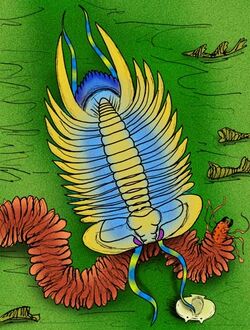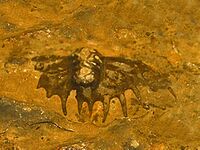Biology:Neodrepanura
| Neodrepanura Temporal range: Guzhangian
| |
|---|---|

| |
| Neodrepanura premesnili | |
| Scientific classification | |
| Kingdom: | |
| Phylum: | |
| Class: | |
| Order: | |
| Family: | |
| Genus: | Neodrepanura Özdikmen, 2006
|
| Type species | |
| Drepanura premesnili Bergeron, 1899
| |
| Species | |
| |
| Synonyms | |
|
Drepanura | |
Neodrepanura is an extinct genus of damesellid odontopleurid trilobite.
Taxonomy
Species of Neodrepanura are better known under the older synonym, Drepanura: the genus was renamed as Neodrepanura in 2006 by Özdikmen when "Drepanura" was discovered to be preoccupied by a springtail described by Schoett 1891.[1]
Fossil record
The various species of Neodrepanura are known from numerous, mostly disarticulated fossils found in Late Cambrian-aged marine limestones of Eastern and Southeastern Asia, especially of Northern China .[1] The genus ranged from about 501 to 497 million years ago during the Guzhangian faunal stage of the late Cambrian Period.
Description
The pygidia, particularly those of N. premesnili, are mined by the Chinese for use as "bat stones" or "swallow stones," as good luck charms and traditional medicines.[2][3] In 2011, the first intact specimen of N. premensnili was found in the Kushan Formation, enabling researchers to better examine the external anatomy of the genus.[1]
References
- ↑ 1.0 1.1 1.2 Liu, Qing, and Qianping Lei. "First known complete specimen of Neodrepanura (Trilobita: Damesellidae) from the Cambrian Kushan Formation, Shandong, China." Alcheringa: An Australasian Journal of Palaeontology 35.3 (2011): 397-403. [1]
- ↑ Peng, S. C. "Historical review of trilobite research in China." Fabulous Fossils—300 years of Worldwide Research on Trilobites. NY State Museum Bulletin, New York State Museum, Albany, New York (2007): 171-191.
- ↑ KOBAYASHI, Teiichi. "On the Damesellidae (Trilobita) in Eastern Asia."Proceedings of the Japan Academy, Series B 63.3 (1987): 59-62.
Wikidata ☰ Q25095039 entry
 |


